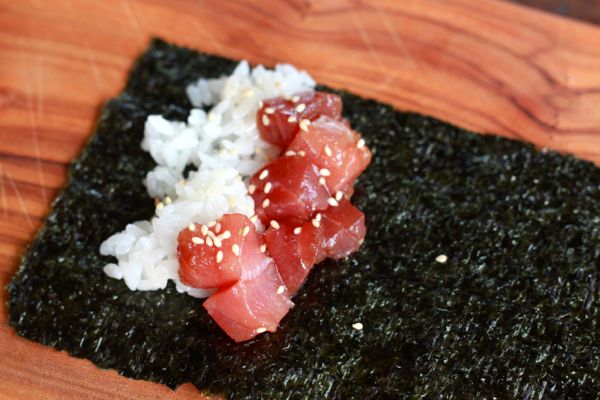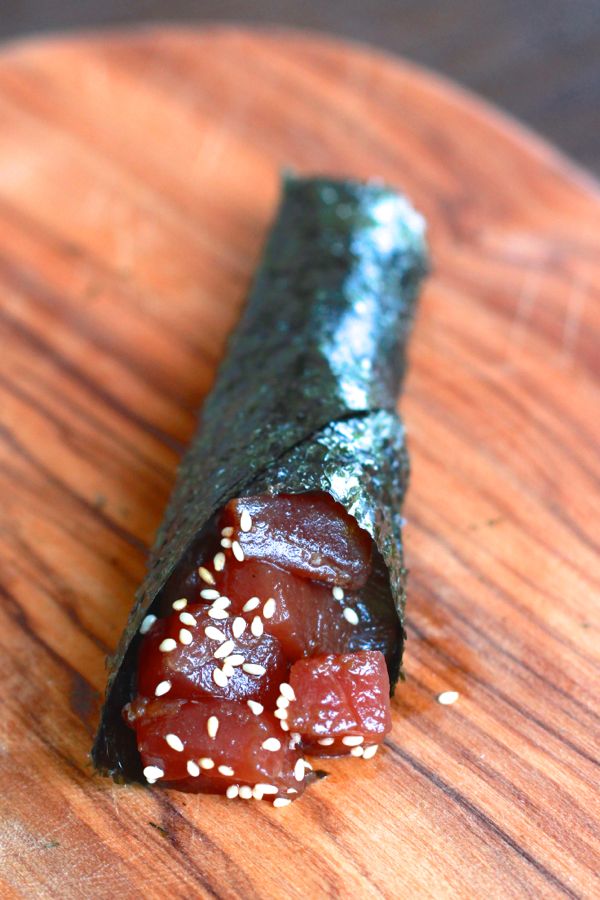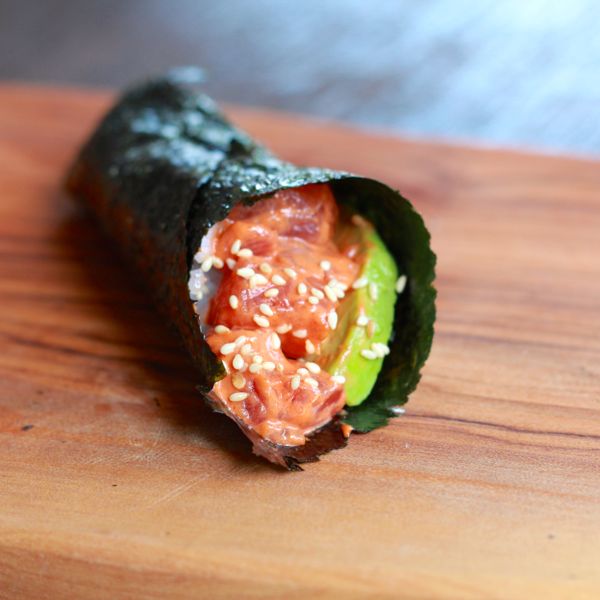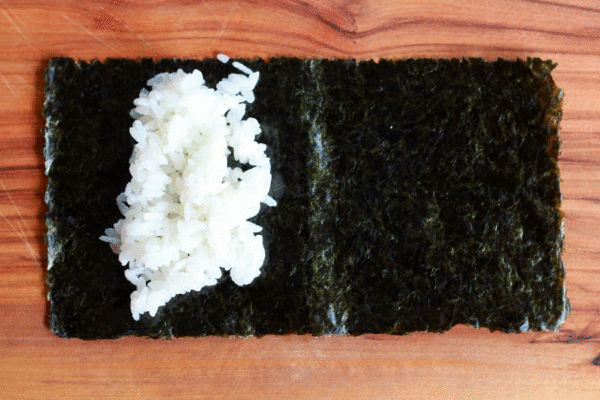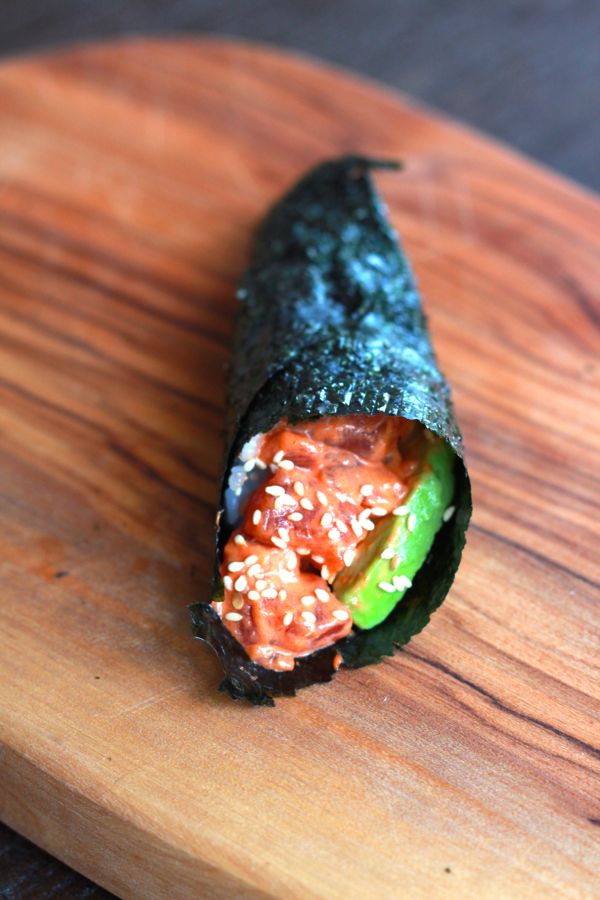 Sushi in Japan is pretty much left up to the experts. People might buy some sashimi at the store and eat the fish without rice, or maybe they’ll make chirashizushi from the trimmings of a different meal. But as far as nigiri or sushi rolls go, forget it. Someone else knows how to do it way better than you do, so you just go to a restaurant and pay someone to make it!
Sushi in Japan is pretty much left up to the experts. People might buy some sashimi at the store and eat the fish without rice, or maybe they’ll make chirashizushi from the trimmings of a different meal. But as far as nigiri or sushi rolls go, forget it. Someone else knows how to do it way better than you do, so you just go to a restaurant and pay someone to make it!
Hand rolls, on the other hand (argh, sorry, couldn’t resist), are a different story. They’re easy to make and fun to eat. You can customize your own based on what you like, too. I made a decidedly not-Japanese spicy tuna roll with avocado, and a slightly more traditional tuna one for my husband who isn’t as in to sriracha as I am. Or try this tuna recipe. You could use salmon (or smoked salmon!). This is a fantastic preparation for uni at home if you can get your lucky little hands on some really fresh sea urchin. Try a crab mixture, or try to replicate a California roll if that’s your kind of thing. Ooh, or go vegetarian with avocado slices and matchsticks of cucumber. So many options! You could have a really great dinner party where everyone gets to chose from a variety of filling to assemble their own rolls.
If you go the fish route though, I can’t stress enough how important it is to use a fish monger that you really trust. The USDA doesn’t monitor what stores call “sushi-grade,” so please be careful. Use a place that knows how to handle sushi-grade fish, and talk to the people behind the counter. If they’re clueless about where the fish came from, that’s probably not a good sign. And if the tuna is even remotely headed in the brown direction (as opposed to a lovely pink), don’t even risk it. Again, there are plenty of options for filling for these little guys if you can’t find sushi-grade tuna.
If you don’t have a rice cooker that plays “Twinkle, Twinkle, Little Star” like our ridiculously cute Japanese rice cooker does, then you may want to follow Maki-san’s excellent advice for making sushi rice. It’s the best non-rice cooker recipe I’ve used.
- 1/2 lb sushi-grade tuna, cut into small cubes
- 3 teaspoons Sriracha
- 2 teaspoons mayo, preferably Japanese kewpie mayo
- 1 teaspoon ponzu or soy sauce
- nori sheets
- about 1 cup prepared sushi rice, slightly warm or at room temperature
- 1/2 avocado, sliced into 8 slices
- toasted sesame seeds for garnish
- Combine the sriracha, mayo and ponzu/soy in a small bowl.
- Add the tuna and toss to combine.
- The mixture can be prepared up to a day in advance.
- Lay the nori sheets flat. Lay about 1/8 cup of sushi rice in a line on the left side of each nori sheet, leaving about 1 inch room at the very left edge and a little room at the bottom edge.
- Lay a slice of avocado on the rice.
- Lay a scoop of the tuna mixture next to the rice.
- Roll the nori into a cone. If you want the nori to hold its shape and stick to itself, brush a bit of water onto the edge of the nori opposite the rice mixture before rolling.
- Top with a few more cubes of tuna and a sprinkle of sesame seeds.
- If you find that your nori is a little bit chewy, try toasting the sheets. Turn your oven burner on low (a gas burner works best) and gently draw the sheets over the heat, one at a time, flipping the sheet over with each pass to do the opposite side. Pass each side of the sheet over the heat 5-10 times, until the seaweed has crisped slightly.
- 1/2 pound sushi-grade tuna, cut into small cubes
- 1 tablespoon ponzu or soy sauce
- 1 teaspoon sesame oil
- 1 teaspoon toasted sesame seeds, plus extra for garnish
- 8 sheets of nori
- 1 cup prepare sushi rice
- Combine the ponzu/soy and sesame oil in a small bowl.
- Add the tuna and sesame seeds and toss to combine.
- The mixture can be prepared up to 6 hours in advance.
- Lay the nori sheets flat. Lay about 1/8 cup of sushi rice in a line on the left side of each nori sheet, leaving about 1 inch room at the very left edge and a little room at the bottom edge.
- Lay a scoop of the tuna mixture on the rice.
- Roll the nori into a cone. If you want the nori to hold its shape and stick to itself, brush a bit of water onto the edge of the nori opposite the rice mixture before rolling.
- Top with a few more cubes of tuna and a sprinkle of sesame seeds.
- If you find that your nori is a little bit chewy, try toasting the sheets. Turn your oven burner on low (a gas burner works best) and gently draw the sheets over the heat, one at a time, flipping the sheet over with each pass to do the opposite side. Pass each side of the sheet over the heat 5-10 times, until the seaweed has crisped slightly.
